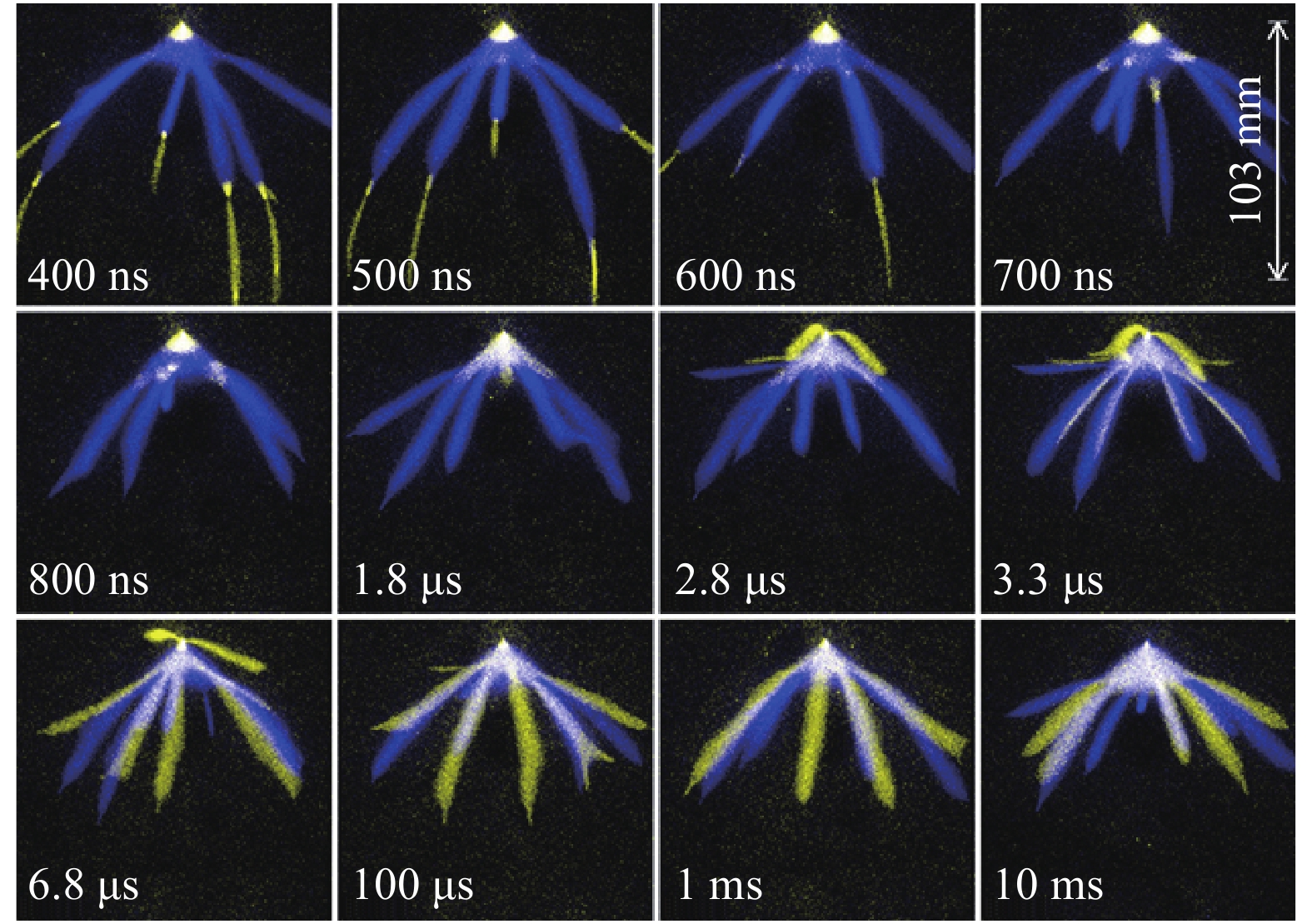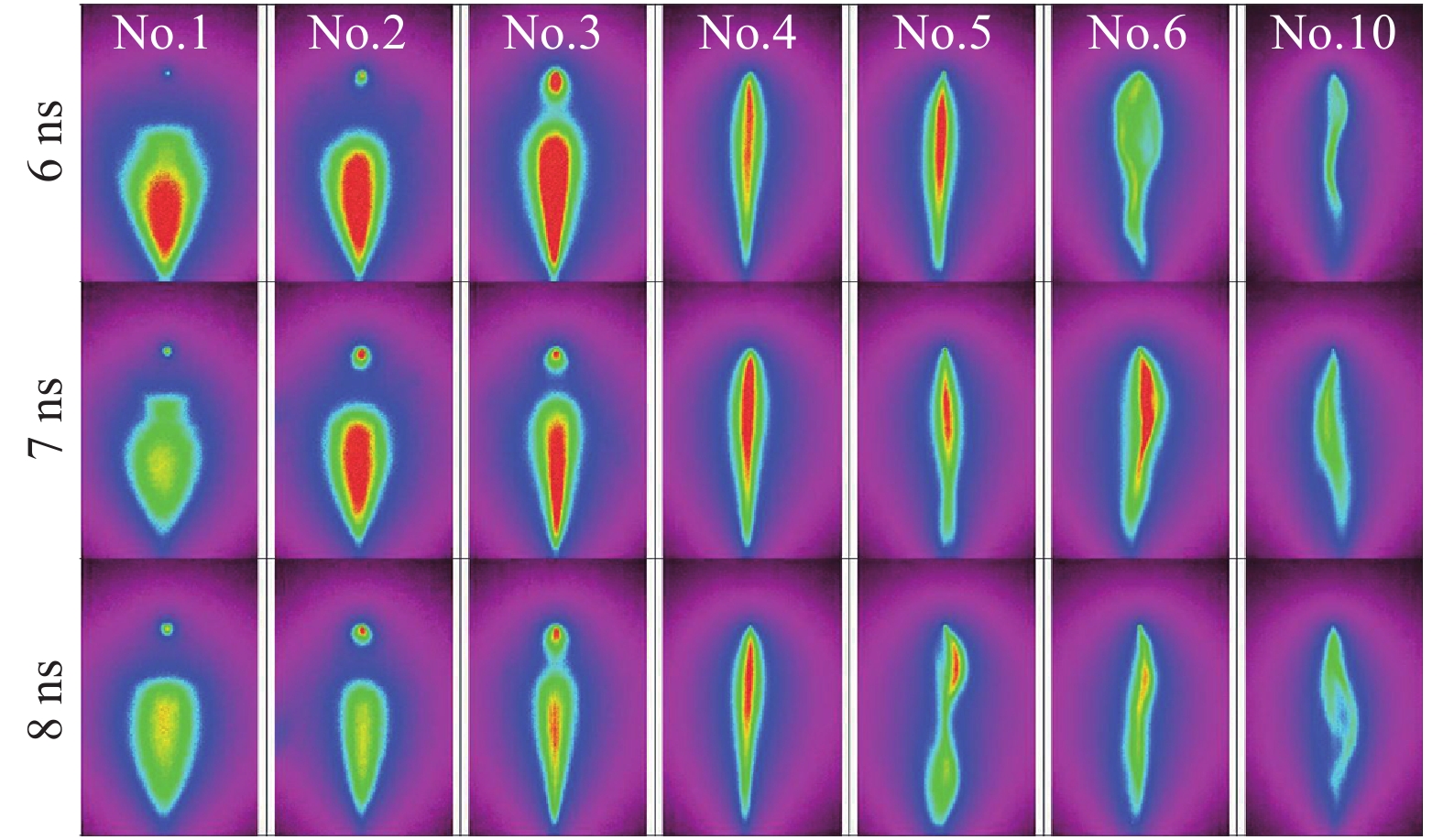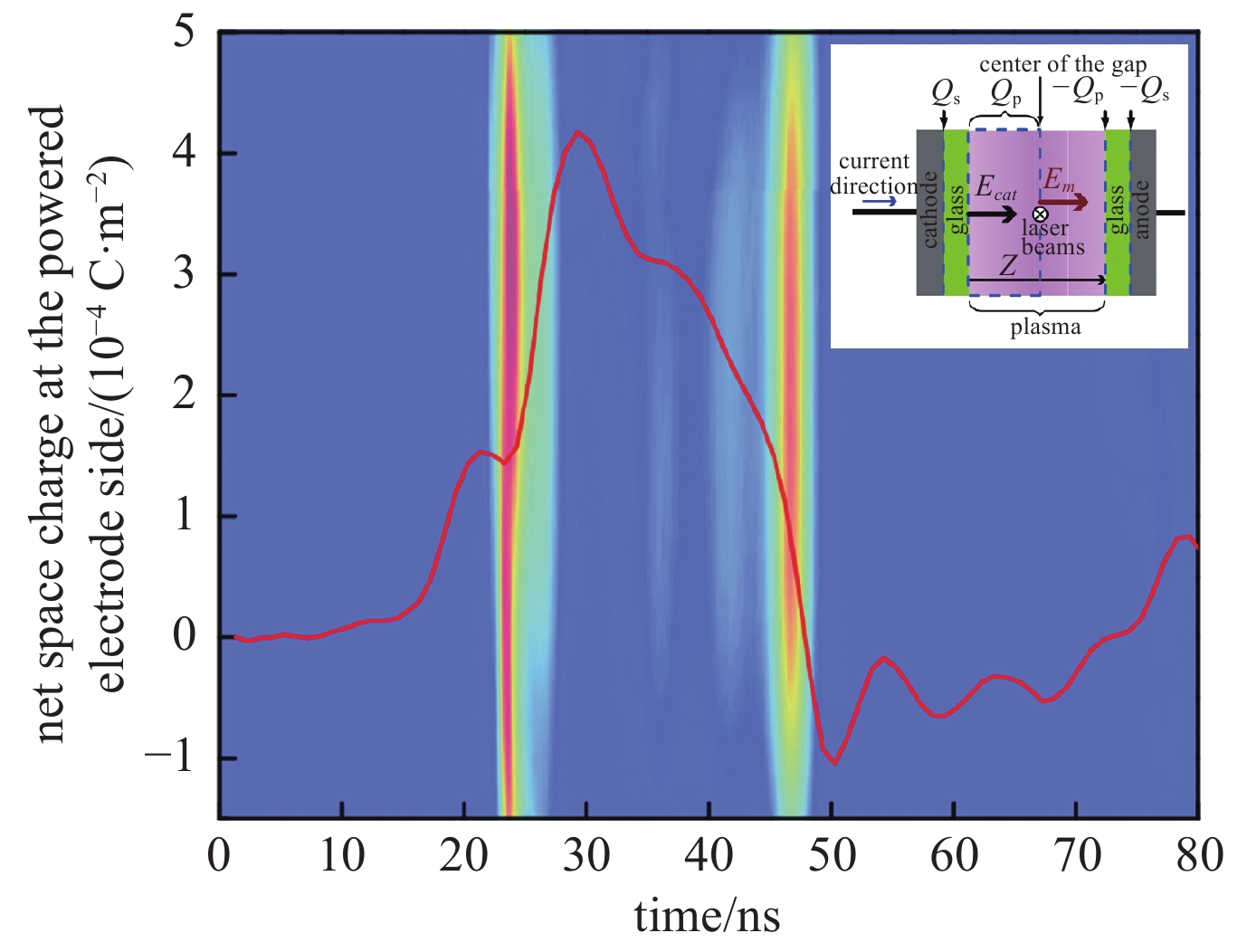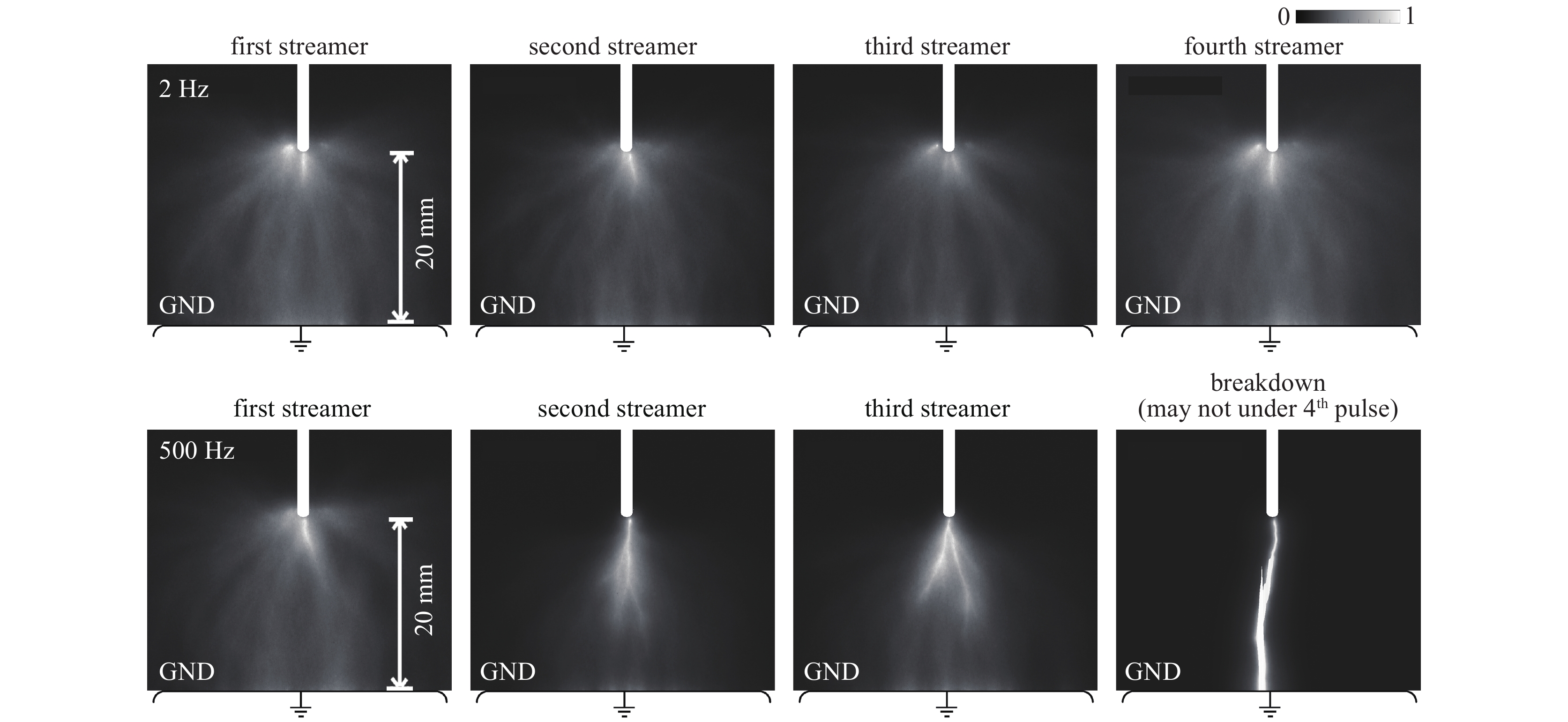Research progress on evolution phenomena and mechanisms of repetitively pulsed streamer discharge
-
摘要: 重复频率脉冲流注放电是低温等离子体前沿应用的关键使能因子,然而,高重复频率脉冲作用下流注放电呈现复杂的不稳定和记忆效应现象,放电基础演变机理和调控方法尚不完善,极大影响应用的安全性和放电特性调控的有效性。综述了重复频率脉冲流注放电演变现象与机制的研究进展。首先归纳了重复频率脉冲流注放电的强非线性和渐进式演变特征,然后分析不同类型放电记忆效应因子对后续流注起始和传播的作用机制,最后总结了脉冲波形参数对重复频率脉冲流注放电的影响规律。凝练了重复频率脉冲流注放电演变机制研究的若干挑战,对脉冲放电等离子体机理研究具有一定的借鉴作用。Abstract: The repetitively pulsed streamer discharge is a critical enabling factor in many advanced low-temperature plasma applications. However, the streamer discharge exhibits complex instabilities and memory effect phenomena under high-frequency repetitive pulses. Fundamental discharge evolution mechanisms and regulation methods are not thoroughly understood, which significantly affects the application safety and regulation efficiency of discharge properties. In this paper, evolution phenomena and mechanisms of repetitively pulsed streamer discharge are reviewed, strong nonlinearity and progressive evolution features are summarized for repetitively pulsed streamer discharge, different memory effect agents and their influential mechanisms on initiation and propagation of subsequent streamers are discussed, effects of pulse waveform parameters on repetitively pulsed streamer discharge are outlined, and several research challenges are proposed regarding evolution mechanisms of repetitively pulsed streamer discharge, which would be helpful for revealing mechanisms of pulsed discharge plasmas.
-
Key words:
- pulsed discharge /
- repetitive frequency /
- streamer /
- memory effect /
- discharge evolution
-
图 5 脉冲间隔时间对正流注通道变化的影响(空气13.3 kPa、幅值13.6 kV、脉宽200 ns)[18]。图中为两次流注放电图像的叠加,首次流注独有区域为蓝色,第二次流注独有区域为黄色,两次流注重叠部分为白色
Figure 5. Effect of the pulse delay time on variations of positive streamer channels (gas pressure: 13.3 kPa, voltage amplitude: 13.6 kV, pulse width: 200 ns). Images were created by superimposing two streamer discharge channels. Areas that only emitted during the first pulse are blue, areas that only emitted during the second pulse are yellow, and areas that emitted during both two pulses are white
表 1 重复频率脉冲气体间隙和气-固沿面放电中部分记忆效应因子类型、影响机制和衰减途径
Table 1. Memory effect agents, influence mechanism and decay path in gas and gas-solid surface discharge under repetitive pulses
memory effect memory effect agents typical examples major influential mechanisms decay processes volume memory effect (1)positive ions ${\rm{N}}_2^ + ,\;{\rm{N}}_4^ + ,\;{\rm{O}}_2^ + ,\;{\rm{O}}_4^ + $ (dependenton gas composition) (1)distort spatial E-field[39]
(2)possibly shield E-field cooperatively with negative ions[18]diffusion
/recombination
/drift(2)negative ions $ {\rm{O}}_2^ - ,\;{\rm{O}}_4^ - ,\;{\rm{SF}}_6^ - $, (dependenton gas composition) (1)distort spatial E-field
(2)possibly shield E-field cooperatively with positive ion [45]
(3)provide seed electrons through detachment process[41]diffusion
/recombination
/drift(3)electrons free electrons facilitate the initiation and guiding the propagation of next streamer (dependent on the spatial distribution) [18, 46] diffusion
/recombination
/attachment/drift
/‘clearing effect’(4)remaining conductivity remaining streamer channel of a certain conductivity inhibit the formation of a streamer (shielding effect on E-field)[18, 38] diffusion
/recombination
/drift(5)metastable and excited species N2(${{\rm{A}}^{\rm{3}}}\Sigma _{\rm{u}}^ + $), N(2D), (dependent on gas composition) (1)super elastic collisions[20, 34-35]
(2)extra energy gain[20, 34-35]
(3)reaction with dielectric[47-48]diffusion
/decay
/loss on wall(6)variation of gas density cylindrical shock wave nearly with the local sound speed (1)affect the distribution of memory effect agents
(2)affect the reduced E-field[37]gas kinetics (7)gas heat accumulation heat released from the discharge energy affect the reduced E-field[14] thermal diffusivity surface memory effect (1)surface trapped charges trapped holes and electrons (1)distort the surface E-field[49-50]
(2)guide volume charge carrier drift and motion
(3)released by disturbances and involved in the next streamer [33, 51, 52]detrapping
/surface conductivity
/surface hopping
/recombination(2)surface destructive aging carbonization and surface roughness (1)high surface conductivity[53, 54]
(2)facilitate the initiation and propagation of surface streamerroughly permanent (3)surface heat accumulation heat from discharge energy (1)surface property degradation [54-55]
(2)decrease local gas pressurethermal diffusivity -
[1] 邵涛, 章程, 王瑞雪, 等. 大气压脉冲气体放电与等离子体应用[J]. 高电压技术, 2016, 42(3):685-705. (Shao Tao, Zhang Cheng, Wang Ruixue, et al. Atmospheric-pressure pulsed gas discharge and pulsed plasma application[J]. High Voltage Engineering, 2016, 42(3): 685-705 [2] 李应红, 吴云. 等离子体激励调控流动与燃烧的研究进展与展望[J]. 中国科学: 技术科学, 2020, 50(10):1252-1273. (Li Yinghong, Wu Yun. Research progress and outlook of flow control and combustion control using plasma actuation[J]. Scientia Sinica (Technologica), 2020, 50(10): 1252-1273 doi: 10.1360/SST-2020-0111 [3] Li Yao, Yang Dezheng, Qiao Junjie, et al. The dynamic evolution and interaction with dielectric material of the discharge in packed bed reactor[J]. Plasma Sources Science and Technology, 2020, 29: 055004. doi: 10.1088/1361-6595/ab844e [4] 张晓星, 肖焓艳, 黄杨珏. 低温等离子体处理SF6废气综述[J]. 电工技术学报, 2016, 31(24):16-24. (Zhang Xiaoxing, Xiao Hanyan, Huang Yangjue. A review of degradation of SF6 waste by low temperature plasma[J]. Transactions of China Electrotechnical Society, 2016, 31(24): 16-24 [5] Zhou Renwu, Zhou Rusen, Wang Peiyu, et al. Plasma-activated water: generation, origin of reactive species and biological applications[J]. Journal of Physics D: Applied Physics, 2020, 53: 303001. doi: 10.1088/1361-6463/ab81cf [6] Mizuno K, Yonetamari K, Shirakawa Y, et al. Anti-tumor immune response induced by nanosecond pulsed streamer discharge in mice[J]. Journal of Physics D: Applied Physics, 2017, 50: 12LT01. doi: 10.1088/1361-6463/aa5dbb [7] Lu X, Naidis G V, Laroussi M, et al. Guided ionization waves: theory and experiments[J]. Physics Reports, 2014, 540(3): 123-166. doi: 10.1016/j.physrep.2014.02.006 [8] 戴栋, 宁文军, 邵涛. 大气压低温等离子体的研究现状与发展趋势[J]. 电工技术学报, 2017, 32(20):1-9. (Dai Dong, Ning Wenjun, Shao Tao. A review on the state of art and future trends of atmospheric pressure low temperature plasmas[J]. Transactions of China Electrotechnical Society, 2017, 32(20): 1-9 [9] 梅丹华, 方志, 邵涛. 大气压低温等离子体特性与应用研究现状[J]. 中国电机工程学报, 2020, 40(4):1339-1358. (Mei Danhua, Fang Zhi, Shao Tao. Recent progress on characteristics and applications of atmospheric pressure low temperature plasmas[J]. Proceedings of the CSEE, 2020, 40(4): 1339-1358 [10] Nijdam S, Teunissen J, Ebert U. The physics of streamer discharge phenomena[J]. Plasma Sources Science and Technology, 2020, 29: 103001. doi: 10.1088/1361-6595/abaa05 [11] Zhao Zheng, Li Jiangtao. Repetitively pulsed gas discharges: memory effect and discharge mode transition[J]. High Voltage, 2020, 5(5): 569-582. doi: 10.1049/hve.2019.0383 [12] Pai D Z, Lacoste D A, Laux C O. Transitions between corona, glow, and spark regimes of nanosecond repetitively pulsed discharges in air at atmospheric pressure[J]. Journal of Applied Physics, 2010, 107: 093303. doi: 10.1063/1.3309758 [13] Zhang Cheng, Shao Tao, Yan Ping, et al. Nanosecond-pulse gliding discharges between point-to-point electrodes in open air[J]. Plasma Sources Science and Technology, 2014, 23: 035004. doi: 10.1088/0963-0252/23/3/035004 [14] Tholin F, Bourdon A. Influence of the external electrical circuit on the regimes of a nanosecond repetitively pulsed discharge in air at atmospheric pressure[J]. Plasma Physics and Controlled Fusion, 2015, 57: 014016. doi: 10.1088/0741-3335/57/1/014016 [15] Ding C, Khomenko A Y, Shcherbanev S A, et al. Filamentary nanosecond surface dielectric barrier discharge. Experimental comparison of the streamer-to-filament transition for positive and negative polarities[J]. Plasma Sources Science and Technology, 2019, 28: 085005. doi: 10.1088/1361-6595/ab2d7a [16] Nijdam S, Wormeester G, Van Veldhuizen E M, et al. Probing background ionization: positive streamers with varying pulse repetition rate and with a radioactive admixture[J]. Journal of Physics D: Applied Physics, 2011, 44: 455201. doi: 10.1088/0022-3727/44/45/455201 [17] Simek M. Determination of N2(A3Σu+) metastable density produced by nitrogen streamers at atmospheric pressure: 2. Experimental verification[J]. Plasma Sources Science and Technology, 2003, 12(3): 454-463. doi: 10.1088/0963-0252/12/3/322 [18] Nijdam S, Takahashi E, Markosyan A H, et al. Investigation of positive streamers by double-pulse experiments, effects of repetition rate and gas mixture[J]. Plasma Sources Science and Technology, 2014, 23: 025008. doi: 10.1088/0963-0252/23/2/025008 [19] Tholin F, Bourdon A. Simulation of the hydrodynamic expansion following a nanosecond pulsed spark discharge in air at atmospheric pressure[J]. Journal of Physics D: Applied Physics, 2013, 46: 365205. doi: 10.1088/0022-3727/46/36/365205 [20] Shao Tao, Sun Guangsheng, Yan Ping, et al. An experimental investigation of repetitive nanosecond-pulse breakdown in air[J]. Journal of Physics D: Applied Physics, 2006, 39(10): 2192-2197. doi: 10.1088/0022-3727/39/10/030 [21] Nagaraja S, Yang V, Adamovich I. Multi-scale modelling of pulsed nanosecond dielectric barrier plasma discharges in plane-to-plane geometry[J]. Journal of Physics D: Applied Physics, 2013, 46: 155205. doi: 10.1088/0022-3727/46/15/155205 [22] Zhao Z, Li J T. Integrated effect on evolution of streamer dynamics under long-term repetitive sub-microsecond pulses in high-pressure nitrogen[J]. Plasma Sources Science and Technology, 2019, 28: 115019. doi: 10.1088/1361-6595/ab556a [23] 赵义焜, 张国强, 韩冬. 高频变压器用匝间绝缘材料沿面放电特性的实验研究[J]. 电工技术学报, 2019, 34(16):3464-3471. (Zhao Yikun, Zhang Guoqiang, Han Dong. Study on surface discharge characteristics of inter-turn insulation materials in high-frequency transformers[J]. Transactions of China Electrotechnical Society, 2019, 34(16): 3464-3471 [24] Fu Pengyu, Zhao Zhibin, Li Xuebao, et al. The role of time-lag in the surface discharge inception under positive repetitive pulse voltage[J]. Physics of Plasmas, 2018, 25: 093518. doi: 10.1063/1.5048729 [25] Pejovic M M, Ristic G S. Memory effects in argon, nitrogen, and hydrogen[J]. IEEE Transactions on Plasma Science, 2002, 30(3): 1315-1319. doi: 10.1109/TPS.2002.802143 [26] Pejović M M, Živanović E, Pejović M M, et al. Analysis of processes responsible for the memory effect in air at low pressures[J]. Plasma Sources Science and Technology, 2010, 19: 045021. doi: 10.1088/0963-0252/19/4/045021 [27] Shao Tao, Sun Guangsheng, Yan Ping, et al. Breakdown phenomena in nitrogen due to repetitive nanosecond-pulses[J]. IEEE Transactions on Dielectrics and Electrical Insulation, 2007, 14(4): 813-819. doi: 10.1109/TDEI.2007.4286511 [28] Pai D Z, Lacoste D A, Laux C O. Nanosecond repetitively pulsed discharges in air at atmospheric pressure-the spark regime[J]. Plasma Sources Science and Technology, 2010, 19: 065015. doi: 10.1088/0963-0252/19/6/065015 [29] 邵涛. 重复频率纳秒脉冲气体击穿研究[D]. 北京: 中国科学院研究生院(电工研究所), 2006.Shao Tao. Study on repetitive nanosecond-pulse breakdown in gases[D]. Beijing: Institute of Electrical Engineering of the Chinese Academy of Sciences, 2006 [30] Pai D Z, Stancu G D, Lacoste D A, et al. Nanosecond repetitively pulsed discharges in air at atmospheric pressure—the glow regime[J]. Plasma Sources Science and Technology, 2009, 18: 045030. doi: 10.1088/0963-0252/18/4/045030 [31] Naidis G V. Simulation of spark discharges in high-pressure air sustained by repetitive high-voltage nanosecond pulses[J]. Journal of Physics D: Applied Physics, 2008, 41: 234017. doi: 10.1088/0022-3727/41/23/234017 [32] Höft H, Kettlitz M, Becker M M, et al. Breakdown characteristics in pulsed-driven dielectric barrier discharges: influence of the pre-breakdown phase due to volume memory effects[J]. Journal of Physics D: Applied Physics, 2014, 47: 465206. doi: 10.1088/0022-3727/47/46/465206 [33] Nemschokmichal S, Tschiersch R, Höft H, et al. Impact of volume and surface processes on the pre-ionization of dielectric barrier discharges: advanced diagnostics and fluid modeling[J]. The European Physical Journal D, 2018, 72: 89. doi: 10.1140/epjd/e2017-80369-1 [34] Acker F E, Penney G W. Influence of previous positive streamers on streamer propagation and breakdown in a positive point-to-plane gap[J]. Journal of Applied Physics, 1968, 39(5): 2363-2369. doi: 10.1063/1.1656561 [35] Hartmann G, Gallimberti I. The influence of metastable molecules on the streamer progression[J]. Journal of Physics D: Applied Physics, 1975, 8(6): 670-680. doi: 10.1088/0022-3727/8/6/010 [36] 蔡新景, 邹晓兵, 王新新. 氮气短间隙的耐受电压和气体密度恢复特性[J]. 高电压技术, 2011, 37(6):1471-1478. (Cai Xinjing, Zou Xiaobing, Wang Xinxin. Recovery of holdoff voltage and gas density in short nitrogen gaps[J]. High Voltage Engineering, 2011, 37(6): 1471-1478 [37] Tholin F, Bourdon A. Influence of temperature on the glow regime of a discharge in air at atmospheric pressure between two point electrodes[J]. Journal of Physics D: Applied Physics, 2011, 44: 385203. doi: 10.1088/0022-3727/44/38/385203 [38] Li Y, Van Veldhuizen E M, Zhang G J, et al. Positive double-pulse streamers: how pulse-to-pulse delay influences initiation and propagation of subsequent discharges[J]. Plasma Sources Science and Technology, 2018, 27: 125003. doi: 10.1088/1361-6595/aaf2c6 [39] Kazemi M R, Sugai T, Tokuchi A, et al. Study of pulsed atmospheric discharge using solid-state LTD[J]. IEEE Transactions on Plasma Science, 2017, 45(8): 2323-2327. doi: 10.1109/TPS.2017.2707105 [40] MacGregor S J, Turnbull S M, Tuema F A, et al. Factors affecting and methods of improving the pulse repetition frequency of pulse-charged and DC-charged high-pressure gas switches[J]. IEEE Transactions on Plasma Science, 1997, 25(2): 110-117. doi: 10.1109/27.602480 [41] Chen She, Heijmans L C J, Zeng Rong, et al. Nanosecond repetitively pulsed discharges in N2-O2 mixtures: inception cloud and streamer emergence[J]. Journal of Physics D: Applied Physics, 2015, 48: 175201. doi: 10.1088/0022-3727/48/17/175201 [42] Komuro A, Ono R. Two-dimensional simulation of fast gas heating in an atmospheric pressure streamer discharge and humidity effects[J]. Journal of Physics D: Applied Physics, 2014, 47: 155202. doi: 10.1088/0022-3727/47/15/155202 [43] Starikovskiy A, Pancheshnyi S, Rakitin A. Periodic pulse discharge self-focusing and streamer-to-spark transition in under-critical electric field[C]//Proceedings of the 49th AIAA Aerospace Sciences Meeting Including the New Horizons Forum and Aerospace Exposition. 2011. [44] Chen Xiancong, Zhu Yifei, Wu Yun. Modeling of streamer-to-spark transitions in the first pulse and the post discharge stage[J]. Plasma Sources Science and Technology, 2020, 29: 095006. doi: 10.1088/1361-6595/ab8e4e [45] Pancheshnyi S. Role of electronegative gas admixtures in streamer start, propagation and branching phenomena[J]. Plasma Sources Science and Technology, 2005, 14(4): 645-653. doi: 10.1088/0963-0252/14/4/002 [46] Tholin F, Bourdon A. Simulation of the stable ‘quasi-periodic’ glow regime of a nanosecond repetitively pulsed discharge in air at atmospheric pressure[J]. Plasma Sources Science and Technology, 2013, 22(4): 045014. doi: 10.1088/0963-0252/22/4/045014 [47] Raĭzer Y P. Gas discharge physics[M]. Berlin: Springer-Verlag, 1991. [48] Golubovskii Y B, Maiorov V A, Behnke J, et al. Influence of interaction between charged particles and dielectric surface over a homogeneous barrier discharge in nitrogen[J]. Journal of Physics D: Applied Physics, 2002, 35(8): 751-761. doi: 10.1088/0022-3727/35/8/306 [49] Deng Junbo, Matsuoka S, Kumada A, et al. The influence of residual charge on surface discharge propagation[J]. Journal of Physics D: Applied Physics, 2010, 43: 495203. doi: 10.1088/0022-3727/43/49/495203 [50] Li Chuanyang, Lin Chuanjie, Zhang Bo, et al. Understanding surface charge accumulation and surface flashover on spacers in compressed gas insulation[J]. IEEE Transactions on Dielectrics and Electrical Insulation, 2018, 25(4): 1152-1166. doi: 10.1109/TDEI.2018.007004 [51] Guaitella O, Marinov I, Rousseau A. Role of charge photodesorption in self-synchronized breakdown of surface streamers in air at atmospheric pressure[J]. Applied Physics Letters, 2011, 98: 071502. doi: 10.1063/1.3552965 [52] Winters C, Petrishchev V, Yin Zhiyao, et al. Surface charge dynamics and OH and H number density distributions in near-surface nanosecond pulse discharges at a liquid/vapor interface[J]. Journal of Physics D: Applied Physics, 2015, 48: 424002. doi: 10.1088/0022-3727/48/42/424002 [53] 李庆民, 刘伟杰, 韩帅, 等. 环氧树脂绝缘高频电热联合老化中局部放电特性分析[J]. 高电压技术, 2015, 41(2):389-395. (Li Qingmin, Liu Weijie, Han Shuai, et al. Analysis on partial discharge characteristics of epoxy resin insulation during high-frequency electrical-thermal aging[J]. High Voltage Engineering, 2015, 41(2): 389-395 [54] Xie Qing, Ren Jie, Huang He, et al. Aging characteristics of epoxy resin discharged by very fast transient overvoltage in SF6[J]. IEEE Transactions on Dielectrics and Electrical Insulation, 2017, 24(2): 1178-1188. doi: 10.1109/TDEI.2017.005866 [55] Chang Chao, Liu Guozhi, Tang Chuanxiang, et al. Review of recent theories and experiments for improving high-power microwave window breakdown thresholds[J]. Physics of Plasmas, 2011, 18: 055702. doi: 10.1063/1.3560599 [56] Zeng Rong, Zhuang Chijie, Yu Zhanqing, et al. Electric field step in air gap streamer discharges[J]. Applied Physics Letters, 2011, 99: 221503. doi: 10.1063/1.3665633 [57] 吴传奇. 冲击电压下长空气间隙正极性流注放电特性研究[D]. 武汉: 华中科技大学, 2014.Wu Chuanqi. Research on the characteristics of long air gap positive streamer discharge under impulse voltage[D]. Wuhan: Huazhong University of Science and Technology, 2014 [58] Nijdam S, Teunissen J, Takahashi E, et al. The role of free electrons in the guiding of positive streamers[J]. Plasma Sources Science and Technology, 2016, 25: 044001. doi: 10.1088/0963-0252/25/4/044001 [59] Yuan Xuchu, Li Hanwei, Abbas M F, et al. A 3D numerical study of positive streamers interacting with localized plasma regions[J]. Journal of Physics D: Applied Physics, 2020, 53: 425204. doi: 10.1088/1361-6463/ab9e38 [60] Babaeva N Y, Naidis G V. Modeling of streamer interaction with localized plasma regions[J]. Plasma Sources Science and Technology, 2018, 27: 075018. doi: 10.1088/1361-6595/aad0d9 [61] Li Chenjie, Huang Zongze, Li Jiangtao, et al. Simulation of the discharge regime transition under repetitive nanosecond pulses in nitrogen at atmospheric pressure[C]//Proceedings of the 2020 IEEE International Conference on High Voltage Engineering and Application (ICHVE). 2020: 9279861. [62] Tarasenko V. Runaway electrons in diffuse gas discharges[J]. Plasma Sources Science and Technology, 2020, 29: 034001. doi: 10.1088/1361-6595/ab5c57 [63] Iza F, Walsh J L, Kong M G. From submicrosecond- to nanosecond-pulsed atmospheric-pressure plasmas[J]. IEEE Transactions on Plasma Science, 2009, 37(7): 1289-1296. doi: 10.1109/TPS.2009.2014766 [64] Ito T, Kanazawa T, Hamaguchi S. Rapid breakdown mechanisms of open air nanosecond dielectric barrier discharges[J]. Physical Review Letters, 2011, 107: 065002. doi: 10.1103/PhysRevLett.107.065002 [65] Komuro A, Ono R, Oda T. Effects of pulse voltage rise rate on velocity, diameter and radical production of an atmospheric-pressure streamer discharge[J]. Plasma Sources Science and Technology, 2013, 22: 045002. doi: 10.1088/0963-0252/22/4/045002 [66] Wang Douyan, Namihira T. Nanosecond pulsed streamer discharges: II. Physics, discharge characterization and plasma processing[J]. Plasma Sources Science and Technology, 2020, 29: 023001. doi: 10.1088/1361-6595/ab5bf6 [67] Liu Zhengyan, Li Jie, Peng Bangfa, et al. Spatiotemporal analysis of streamer discharge in a wire-to-wire reactor with positive nanosecond pulse supply[J]. Journal of Physics D: Applied Physics, 2020, 53: 465203. doi: 10.1088/1361-6463/abaa16 [68] Korolev Y D, Mesyats G A. Physics of pulsed breakdown in gases[M]. Yekaterinburg: URO Press, 1998. [69] Wang Douyan, Okada S, Matsumoto T, et al. Pulsed discharge induced by nanosecond pulsed power in atmospheric air[J]. IEEE Transactions on Plasma Science, 2010, 38(10): 2746-2751. doi: 10.1109/TPS.2010.2052369 [70] Qi Fei, Li Yiyang, Zhou Rusen, et al. Uniform atmospheric pressure plasmas in a 7 mm air gap[J]. Applied Physics Letters, 2019, 115: 194101. doi: 10.1063/1.5120109 [71] Huang Bangdou, Takashima K, Zhu Ximing, et al. The influence of the repetition rate on the nanosecond pulsed pin-to-pin microdischarges[J]. Journal of Physics D: Applied Physics, 2014, 47: 422003. doi: 10.1088/0022-3727/47/42/422003 [72] Huang Bangdou, Carbone E, Takashima K, et al. The effect of the pulse repetition rate on the fast ionization wave discharge[J]. Journal of Physics D: Applied Physics, 2018, 51: 225202. doi: 10.1088/1361-6463/aabf2d [73] Zhao Z, Huang D D, Wang Y N, et al. Evolution of streamer dynamics and discharge mode transition in high-pressure nitrogen under long-term repetitive nanosecond pulses with different timescales[J]. Plasma Sources Science and Technology, 2019, 28: 085015. doi: 10.1088/1361-6595/ab2b86 [74] Popov N A. Investigation of the mechanism for rapid heating of nitrogen and air in gas discharges[J]. Plasma Physics Reports, 2001, 27(10): 886-896. doi: 10.1134/1.1409722 [75] Popov N A. Fast gas heating in a nitrogen–oxygen discharge plasma: I. Kinetic mechanism[J]. Journal of Physics D: Applied Physics, 2011, 44: 285201. doi: 10.1088/0022-3727/44/28/285201 [76] Mintoussov E I, Pendleton S J, Gerbault F G, et al. Fast gas heating in nitrogen–oxygen discharge plasma: II. Energy exchange in the afterglow of a volume nanosecond discharge at moderate pressures[J]. Journal of Physics D: Applied Physics, 2011, 44: 285202. doi: 10.1088/0022-3727/44/28/285202 [77] Xu D A, Lacoste D A, Rusterholtz D L, et al. Experimental study of the hydrodynamic expansion following a nanosecond repetitively pulsed discharge in air[J]. Applied Physics Letters, 2011, 99: 121502. doi: 10.1063/1.3641413 [78] Rusterholtz D L, Lacoste D A, Stancu G D, et al. Ultrafast heating and oxygen dissociation in atmospheric pressure air by nanosecond repetitively pulsed discharges[J]. Journal of Physics D: Applied Physics, 2013, 46: 464010. doi: 10.1088/0022-3727/46/46/464010 [79] 章程, 顾建伟, 邵涛, 等. 大气压空气中重复频率纳秒脉冲气体放电模式研究[J]. 强激光与粒子束, 2014, 26:045029. (Zhang Cheng, Gu Jianwei, Shao Tao, et al. Discharge mode in the repetitive nanosecond-pulse discharge in atmospheric pressure air[J]. High Power Laser and Particle Beams, 2014, 26: 045029 doi: 10.11884/HPLPB201426.045029 [80] Shao Tao, Zhang Cheng, Niu Zheng, et al. Diffuse discharge, runaway electron, and x-ray in atmospheric pressure air in an inhomogeneous electrical field in repetitive pulsed modes[J]. Applied Physics Letters, 2011, 98: 021503. doi: 10.1063/1.3540504 -





 下载:
下载:












